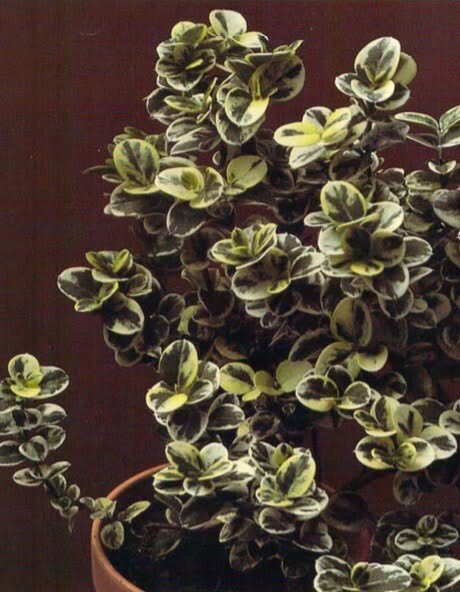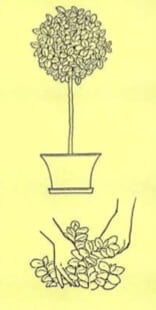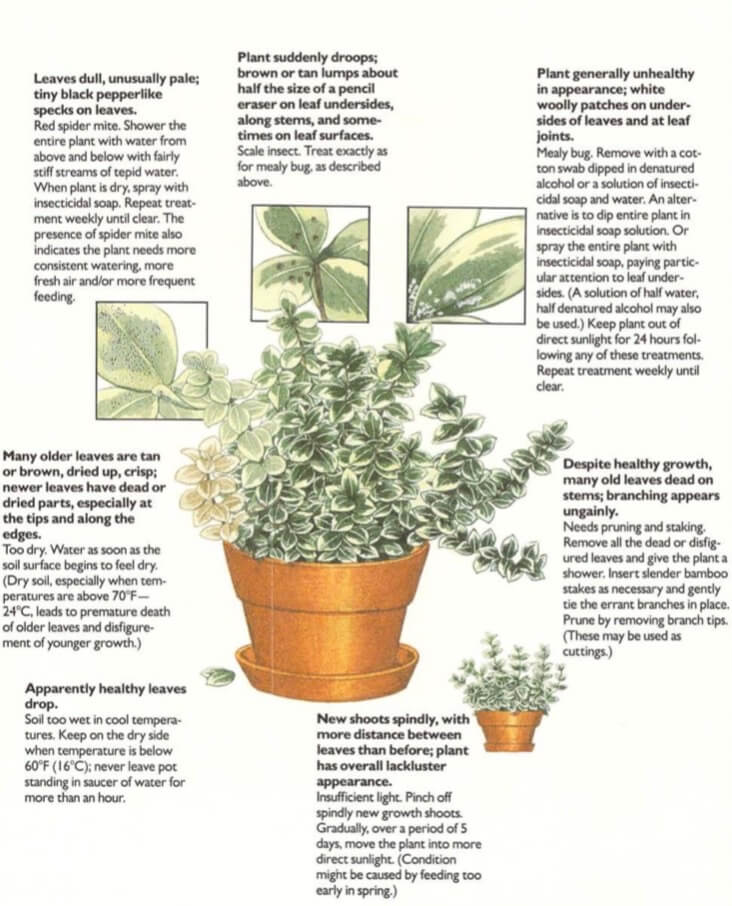[Ebook Việt Hoá] The Instant Guide to Healthy Houseplants (Hướng dẫn tức thời để chăm cây trong nhà khoẻ mạnh), Chi Carissa
[Ebook Việt Hoá] The Instant Guide to Healthy Houseplants: Carissa humphreyii variegata (Variegated natal plum)
- Nguồn: [Ebook Việt Hoá] The Instant Guide to Healthy Houseplants (Hướng dẫn tức thời để chăm cây trong nhà khoẻ mạnh)
- Biên tập: Dũng Cá Xinh
- Biên dịch: Team Codai.net
English
The variegated natal plum, which is sometimes listed as Carissa humplzreyii variegata and sometimes as Carissa ‘Humphrey Variegata,’ has been rightly called one of the best houseplants for a number of reasons. It has attractive, durable foliage; it thrives in home temperatures year round; it grows naturally as a small, rounded bush and it is easy to train as a miniature tree-form standard or bonsai. Under ideal conditions, the plant will produce pure white pinwheel-shaped flowers followed by fruit that is edible but tart.

Light
Prefers full available sunlight but will adapt in any bright window that receives some direct sunlight.
Temperature
Grows best when temperatures range between 60 and 80°F (16 and 26°C). Higher temperatures are acceptable if air circulates freely and soil is kept moist. In temperatures below 60°F (16°C), plant becomes semi dormant and needs only enough water to keep soil damp.
Soil
Ideal mix is a combination of equal parts garden loam or all-purpose potting soil; clean, sharp sand (or perlite) and peat moss (or well-rotted leaf mold or compost). Soilless mix may also be used.
Water
In summer, water every 1-2 days. In other seasons, water about every 4 or 5 days, or when soil surface is dry to the touch.
Humidity
Daily misting is beneficial in warm weather. Give plant a tepid shower once a week to keep leaves rain-fresh and to discourage insect infestation. Stand pot in saucer of pebbles almost covered with water. Note: Though these treatments are ideal for the natal plum, it will also grow well without them, provided soil is kept moist.
Feeding
Use houseplant food at half themanufacturer’s recommendedstrength every 14 days inspring and summer. If soil is loam-based, use fish emulsion
Cleaning
Shower plant weekly in tepid water. (Mist daily in warm weather.) Use no leafshine.
Repotting
Repot annually in late winter or spring in same size pot. To pro- mote more rapid growth, use pot a size or two larger.
Pruning/Training
For a bushy effect, pinch out the tip of each new branch when it is 1-2 in (2.5-5 cm) long. Various bonsai techniques may also be used, or the plant may be trained as a tree-form standard.
Cuttings
- 1. Take stem-tip cuttings 2 in (5 cm) long in spring. Remove leaves from bottom half inch (1 cm) of stem.
- 2. Dip bare stem in hormone rooting powder, then plant in a sand and peat moss mix and keep covered at 70°F (24°C) for 2-4 weeks.
Repot annually in late winter or spring in same size pot. To pro- mote more rapid growth, use pot a size or two larger.

What goes wrong

- Leaves dull, unusually pale; tiny black pepperlike specks on leaves: Red spider mite. Shower the entire plant with water from above and below with fairly stiff streams of tepid water. When plant is dry. spray with insecticidal soap. Repeat treatment weekly until clear. The presence of spider mite also indicates the plant needs more consistent watering. more fresh air and/or more frequent feeding .
- Plant suddenly droops; brown or tan lumps about half the size of a pencil eraser on leaf undersides, along stems, and some- times on leaf surfaces: Scale insect. Treat exactly as for mealy bug. as described above.
- Plant generally unhealthy in appearance; white woolly patches on under-sides of leaves and at leaf joints: Mealy bug. Remove with a cot- ton swab dipped in denatured alcohol or a solution of insecticidal soap and water. An alter- native is to dip entire plant in insecticidal soap solution. Or spray the entire plant with insecticidal soap, paying particular attention to leaf under- sides. (A solution of half water. half denatured alcohol may also be used.) Keep plant out of direct sunlight for 24 hours following any of these treatments. Repeat treatment weekly until clear.
- Despite healthy growth, many old leaves dead on stems; branching appears ungainly: Needs pruning and staking. Remove all the dead or disfigured leaves and give the plant a shower. Insert slender bamboo stakes as necessary and gently tie the errant branches in place. Prune by removing branch tips. (These may be used as cuttings.)
- Many older leaves are tan or brown, dried up, crisp; newer leaves have dead or dried parts, especially at the tips and along the edges: Too dry. Water as soon as the soil surface begins to feel dry. (Dry soil. especially when temperatures are above 70°F – 24°C. leads to premature death of older leaves and disfigurement of younger growth.)
- Apparently healthy leaves drop: Soil too wet in cool temperatures. Keep on the dry side when temperature is below 60°F (16°C); never leave pot standing in saucer of water for more dian an hour.
- New shoots spindly, with more distance between leaves than before; plant has overall lackluster appearance: Insufficient light. Pinch off spindly new growth shoots. Gradually, over a period of 5 days, move the plant into more direct sunlight. (Condition might be caused by feeding too early in spring.)
Tiếng Việt
Cây mận natal đầy màu sắc, đôi khi được kể đến Carissa humplzreyii variegata hay là Carissa ‘Humphrey Variegata,’ là một trong những loại cây trồng trong nhà tốt nhất cũng có lý do. Cây có tán lá hấp dẫn, bền; nó phát triển mạnh ở nhiệt độ phòng quanh năm; mọc tự nhiên như một bụi nhỏ, tròn và rất dễ trở thành dạng cây thu nhỏ tiêu chuẩn hoặc cây cảnh. Trong điều kiện lý tưởng, cây sẽ nở ra những bông hoa hình chong chóng trắng tinh, sau đó là quả có thể ăn được nhưng có vị chua.

Ánh sáng
Thích ánh sáng mặt trời đầy đủ nhưng sẽ thích nghi trong bất kỳ cửa sổ sáng nào nhận ánh nắng mặt trời trực tiếp.
Nhiệt độ
Phát triển tốt nhất khi nhiệt độ từ 60 đến 80 ° F (16 đến 26 ° C). Nhiệt độ cao hơn vẫn được nếu không khí lưu thông tốt và đất được giữ ẩm. Ở nhiệt độ dưới 60 ° F (16 ° C), cây sẽ ngủ đông và chỉ cần đủ nước để giữ ẩm cho đất.
Đất
Hỗn hợp lý tưởng là kết hợp đất mùn vườn hoặc đất bầu đa năng các phần bằng nhau; cát sạch, sắc (hoặc đá trân châu) và rêu than bùn (hoặc nấm mốc hoặc phân trộn đã mục nát). Hỗn hợp đất sạch có thể được sử dụng.
Nước
Vào mùa hè, tưới 1-2 ngày một lần. Vào các mùa khác, tưới khoảng 4 hoặc 5 ngày một lần, hoặc chạm vào thấy bề mặt đất khô.
Độ ẩm
Phun sương hàng ngày có lợi trong thời tiết ấm áp. Tưới cây bằng nước ấm một lần mỗi tuần để giữ cho lá luôn tươi tốt và ngăn côn trùng xâm nhập. Đặt chậu trong một đĩa sỏi gần như phủ đầy nước.
Lưu ý: Mặc dù những cách xử lý này là lý tưởng cho cây mận non, nó vẫn sẽ phát triển tốt nếu không có chúng, miễn là đất được giữ ẩm.
Bón phân
Sử dụng phân bón hữu cơ một nửa lượng khuyến nghị của nhà sản xuất 14 ngày một lần vào mùa xuân và mùa hè. Nếu đất là mùn, hãy sử dụng phân bón đạm cá.
Làm sạch
Tưới cây hàng tuần với nước ấm. (Phun sương hàng ngày khi thời tiết ấm áp.) Không sử dụng xịt bóng lá.
Thay chậu
Thay chậu hàng năm vào cuối mùa đông hoặc mùa xuân trong chậu cùng kích thước. Để thúc đẩy sự phát triển nhanh chóng hơn, hãy sử dụng chậu lớn hơn một đến hai kích thước.
Cắt tỉa / Uốn cây
Để cây trở nên rậm rạp, hãy kẹp phần đầu của mỗi nhánh mới khi nó dài 1-2 inch (2,5-5 cm). Các kỹ thuật bonsai khác nhau cũng có thể được sử dụng, hoặc có thể uốn cây thành hình dạng tiêu chuẩn.
Cắt tỉa
- 1. Lấy cành giâm ở ngọn thân có độ dài 2 inch (5 cm) vào mùa xuân. Loại bỏ nửa inch (1 cm) của các lá dưới cùng thân cây.
- 2. Nhúng thân cây trần vào bột kích thích ra rễ, sau đó trồng trong cát và than bùn trộn rêu rồi giữ ở nhiệt độ 70 ° F (24 ° C) trong 2-4 tuần.

Những vấn đề có thể xảy ra

- Lá xỉn màu, nhợt nhạt bất thường; những đốm đen nhỏ như hạt tiêu trên lá: Nhện đỏ. Tưới nước từ trên xuống dưới cho toàn bộ cây bằng nước ấm khá cứng. Khi cây khô, phun xà phòng diệt côn trùng. Lặp lại điều trị hàng tuần cho đến khi khỏi hẳn. Sự hiện diện của mạt nhện cũng cho thấy cây cần được tưới nước đều đặn hơn, không khí trong lành hơn và bón phân thường xuyên hơn.
- Cây đột nhiên rũ xuống; Các cục màu nâu hoặc nâu vàng nhạt có kích thước bằng một nửa cục tẩy bút chì ở mặt dưới lá, dọc theo thân và đôi khi trên bề mặt lá: Vảy côn trùng. Điều trị như đối với rệp sáp (đã mô tả ở trên).
- Nhìn bên ngoài thấy cây không được khỏe; các mảng lông tơ màu trắng ở mặt dưới lá và ở các khớp lá: Rệp sáp. Tẩy bằng tăm bông nhúng vào cồn biến tính hoặc dung dịch xà phòng diệt côn trùng và nước. Một phương pháp khác là nhúng toàn bộ cây vào dung dịch xà phòng diệt côn trùng. Hoặc xịt toàn bộ cây bằng xà phòng diệt côn trùng, đặc biệt chú ý đến mặt dưới lá. (Cũng có thể sử dụng dung dịch gồm nửa nước nửa cồn biến tính.) Để cây tránh ánh nắng trực tiếp trong 24 giờ sau khi thực hiện bất kỳ phương pháp xử lý nào trong số này. Lặp lại điều trị hàng tuần cho đến khi khỏi hẳn.
- Mặc dù cây phát triển khỏe mạnh nhưng trên thân cây nhiều lá già chết; nhánh mọc lộn xộn: Cần tỉa cành và dựng cọc. Loại bỏ tất cả các lá chết hoặc biến dạng và tưới cây. Nếu cần thiết hãy chèn các cọc tre mảnh và nhẹ nhàng buộc các cành sai vị trí vào. Cắt tỉa bằng cách loại bỏ các ngọn cành. (Chúng có thể được sử dụng làm cành giâm.)
- Nhiều lá già có màu nâu vàng nhạt hoặc nâu, khô héo, giòn; những lá mới chết hoặc khô, đặc biệt là ở ngọn và dọc theo mép: Quá khô. Tưới nước ngay khi bề mặt đất bắt đầu khô. (Đất khô. Đặc biệt là khi nhiệt độ trên 70 ° F – 24 ° C dẫn đến lá già bị chết sớm và làm biến dạng chồi non.)
- Lá khỏe mạnh bị rụng: Đất quá ẩm ướt ở nhiệt độ mát. Giữ ở nơi khô ráo khi nhiệt độ dưới 60 ° F (16 ° C); không bao giờ để chậu trong đĩa nước hơn một giờ.
- Chồi mới khẳng khiu, với khoảng cách giữa các lá dài hơn trước; cây có vẻ ngoài mờ nhạt: Không đủ ánh sáng. Chặt các chồi mới mọc khẳng khiu. Dần dần, trong khoảng thời gian 5 ngày, chuyển cây ra nơi có ánh nắng trực tiếp nhiều hơn. (Tình trạng có thể do bón phân quá sớm vào mùa xuân.)
![[Ebook Việt Hoá] The Instant Guide to Healthy Houseplants: Carissa humphreyii variegata (Variegated natal plum) [Ebook Việt Hoá] The Instant Guide to Healthy Houseplants: Carissa humphreyii variegata (Variegated natal plum)](https://vn1.vdrive.vn/codai.net/2020/02/ebook-huong-dan-tuc-thoi-cham-cay-trong-nha-khoe-manh-55-carissa-humphreyii-variegata.jpg)


